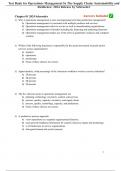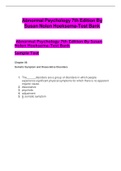Test Bank for Operations Management In The Supply Chain: Sustainability and
Resilience: 2024 Release by Schroeder
Chapter 01 2024 Schroeder Answers Included ✅
1) Why is operations management a more encompassing term than production management?
A) Operations management is concerned with multiple products and services.
B) Operations management refers to service as well as manufacturing organizations.
C) Operations management is broader including the financing and marketing functions.
D) Operations management makes use of the tools of quantitative analysis and computer
systems.
2) Which of the following functions is responsible for the actual movement of goods and/or
services across organizations?
A) logistics
B) operations
C) purchasing
D) None of these choices are correct.
3) Approximately, what percentage of the American workforce works in service industries?
A) 20 percent
B) 40 percent
C) 80 percent
D) 90 percent
4) The five decision areas in operations management are
A) planning, technology, inventory, control, and services.
B) process, quality, capacity, inventory, and supply chain.
C) process, quality, technology, capacity, and production.
D) None of these choices are correct.
5) A productive process approach
A) views operations as a separate organizational function.
B) must provide feedback information for control of process inputs and technology.
C) is of limited use in service organizations.
D) disregards human and social concerns.
1
,6) Capacity decisions
A) include staffing and scheduling.
B) include inventory control.
C) include defining product specifications.
D) None of these choices are correct.
7) Inventory decisions involve
A) determining what to order, how much to order, and when to order.
B) tracking the flow of materials.
C) managing the finished goods inventories.
D) All of these choices are correct.
8) The essence of operations management can be described by
A) process, capacity, and people.
B) decisions, function, and process.
C) planning, control, and organization.
D) integrated planning and control.
9) The three primary functions that exist in most business organizations are
A) operations, accounting, and finance.
B) operations, production, and finance.
C) production, marketing, and human resources.
D) operations, finance, and marketing.
10) The three major functions of business organizations
A) are mutually exclusive.
B) function independently of each other.
C) interface with each other.
D) do not interface with each other.
2
,11) Which one of the following would NOT generally be classified under the heading of input in
a university system?
A) staff
B) equipment
C) facilities
D) knowledge
E) research
12) The five major decision responsibilities of operations management are
A) process, quality, capacity, sourcing, and human resources.
B) process, quality, human resources, logistics, and inventory.
C) quality, inventory, human resources, capacity, and supply chain.
D) process, capacity, quality, supply chain, and inventory.
13) Which of the following does NOT come under the process category of the operations
decision framework?
A) layout of the facility
B) job design
C) the type of equipment and technology
D) product or service inspection
14) Supply chain management includes the integration of
A) suppliers.
B) manufacturers.
C) customers.
D) All of these choices are correct.
15) The supply chain extends from
A) raw material suppliers to manufacturing.
B) raw material suppliers to supplier.
C) dealer to customer.
D) raw material supplier to customer.
3
, 16) Supply chain management includes all of the following except
A) purchasing.
B) inventory control.
C) advertising.
D) customer service.
17) A comprehensive decision-making framework for operations includes
A) consideration of other organizational functions.
B) consideration of operations in isolation of other functions.
C) suppliers but not customers.
D) customers but not suppliers.
18) Common inputs to the operations transformation process include all of the following
EXCEPT
A) raw materials.
B) energy.
C) capacity.
D) labor.
E) conversion processes.
19) The major decision responsibilities of the operations and supply chain management include
all of the following EXCEPT
A) quality.
B) process.
C) capacity.
D) capability.
E) inventory.
20) Key elements/events that should be monitored in the firm’s external environment include all
of the following EXCEPT
A) competitors.
B) political events.
C) economic events.
D) social trends
E) All of them should be monitored.
4





